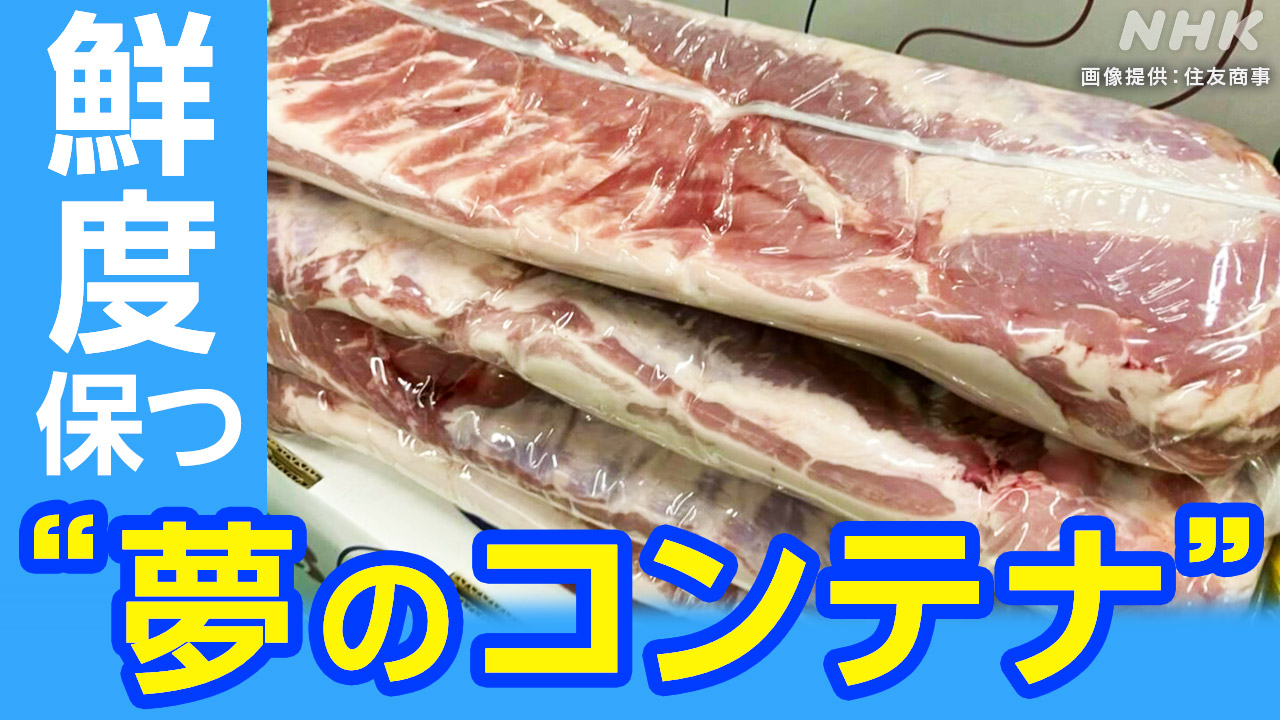New technology for transporting fresh food "raw" long distances by ship February 28, 16:53
A major Japanese trading company has put into practical use a new technology that allows
raw pork from Spain to be transported to Japan by ship .
A transport ship is forced to divert its maritime route through the Red Sea due to a series of attacks on ships by the Houthis.
What is the “dream container” that keeps fresh food fresh even if it takes a long time to transport?
(Economics Department reporter Mako Kawasaki)
“Dream container” has arrived
At around 7:30 pm on February 14th, a large container ship arrived at Tokyo Port from Europe.
One of the loaded containers is the "Dream Container."
Due to heightened tensions around the Red Sea, the container ship reportedly turned back midway and detoured to the Cape of Good Hope in South Africa before arriving in Japan.
Although the shipping period took about a month longer than originally planned, the Spanish pork loaded in the container remained fresh.
While fresh foods loaded onto container ships are often transported in a frozen state, when chilled food is transported by ship, the limit is for short periods and short distances, and for long distances, it is transported by air cargo.
What kind of technology?
What kind of technology is used in the dream container?
I was able to see it at the scene.
The interior of the container is kept at sub-zero room temperature.
They are plugged into power on board the ship, and then plugged back in at port, except for a few minutes while they are being unloaded by crane.
The key new technology was inside the container.
The entire ceiling is covered with metal plates.
By applying a voltage to it, a state called an ``electric field'' is created.
Then, the water molecules inside the food become electrically charged and rotate.
When fresh foods are thawed from a frozen state, their cell membranes are destroyed, reducing their freshness.
By rotating the water molecules, it is possible to transport them for long periods of time without freezing, even at sub-zero temperatures.
The company claims that this new technology can double or triple the length of chilled transportation for many foods.
[Transportation examples]
▽Pork: Previously around 20 days → around 60 days
▽Fish, salmon, and cut flowers: Up until now, mainly air transport → now possible to transport by ship
Toward the world's first commercialization
Sumitomo Corporation, which developed the new technology, said it has spent about three years developing and conducting demonstration experiments.
On February 28th, we announced a business partnership with OOCL, a major shipping company in Hong Kong, and will be the world's first commercial company.
Takashi Yanai, General Manager
: ``The key to this technology is that it doesn't freeze even though it would normally freeze.If the temperature is too low, it will freeze, and if it's too high, it will rot.This is a strange, but extremely delicate operation. I’ve come.”
Itoham Yonekyu Holdings has decided to use this container to import pork.
In the future, trading companies and shipping companies hope to expand to include fresh fish, chicken, and flowers.
Growing geopolitical risks in maritime transport
Currently, shipping around the world is being restricted not only around the Red Sea, but also in the Panama Canal due to water shortages caused by record drought.
Once such a situation occurs, sea transportation in particular is likely to lead to a significant lengthening of transportation time and increased costs due to route detours.
There are high hopes for this as a means of dealing with such risks.
Are the fresh foods that reach Japan becoming more diverse?
Furthermore, it is likely to bring about changes in the imported foods that line up on our dinner tables.
For example, in the case of pork, imports were mainly from relatively nearby countries such as North America and Australia, and pork from Europe was considered a luxury item, as it had to be transported by air.
Switching to sea transport could also reduce prices.
Takashi Yanai, General Manager
: ``We will be able to deliver meat from Europe at a lower price while maintaining freshness.If the number of sources of pork imports increases for Japan, we will have a chance to eat more stable and delicious pork.'' We can increase it.”
《Postscript of the interview》
The trading company says that the dream container also has an environmental feature: it emits less carbon dioxide during transportation than air transportation.
In terms of global food security, the diversification of transportation routes holds great promise for Japan.
Fresh food is delivered to Japanese tables every day from all over the world.
When I interviewed a large ship up close at the port, I realized once again that one of the things that supports this is maritime transportation.
The emergence of new technology is a world that is very familiar to us.
Economic Affairs Department reporter
Mako Kawasaki Joined the department
in 2017 After working
at the Matsuyama Bureau, she is currently with the department

